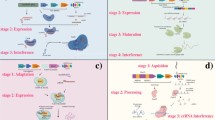Abstract
A novel method for selection of transgenic plants utilizing the sweet pepper (Capsicum annuum L.) ferredoxin-like protein (pflp) gene as selection marker and Erwinia carotovora as the selection agent has been developed. An expression vector containing a pflp cDNA driven by a cauliflower mosaic virus 35S promoter was successfully transformed into protocorm-like bodies of Oncidium orchid by Agrobacterium tumefaciens and particle bombardment, respectively. Erwinia carotovora was used as a selection agent to screen transformants, thereby obtaining transgenic plants without the use of an antibiotic selection agent. A total of 32 independent transgenic orchid lines were obtained, out of which 9 transgenic lines (β-glucuronidase positive) were randomly selected and confirmed by Southern and northern blot analyses. The transgenic orchid plants showed enhanced resistance to E. carotovora, even when the entire plant was challenged with the pathogen. Our results suggest the novel use of the pflp gene as a resistance selection marker in plant genetic engineering strategies. In the future, the use of the pflp gene as a selection marker may facilitate the use of smaller gene constructs due to removal of bulky antibiotic selection and reporter genes. These constructs can then be used to incorporate additional genes of choice.




Similar content being viewed by others
Abbreviations
- CaMV:
-
cauliflower mosaic virus
- GUS:
-
β-glucuronidase
- PLB:
-
protocorm-like body
- WT:
-
wild type
References
Anzai H, Ishii Y, Schichinohe M, Katsumata K, Nojiri C, Morikawa H, Tanaka M (1996) Transformation of Phalaenopsis by particle bombardment. Plant Tissue Cult Lett 13:265–271
Belarmino MM, Mii M (2000) Agrobacterium-mediated genetic transformation of a Phalaenopsis orchid. Plant Cell Rep 19:435–442
Chan MT, Yu SM (1998) The 3′-untranslated region of a rice alpha-amylase gene functions as a sugar-dependent mRNA stability determinant. Proc Natl Acad Sci USA 95:6543–6547
Chan MT, Chang HH, Ho S L, Tong WF, Yu SM (1993) Agrobacterium-mediated production of transgenic rice plants expressing a chimeric alpha-amylase promoter/beta-glucuronidase gene. Plant Mol Biol 22:491–506
Chan MT, Chao YC, Yu SM (1994) A novel gene expression system for plant cells based on the carbohydrate-starvation-inducible α-amylase promoter. J Biol Chem 269:17635–17641
Chia TF, Chan YS, Chua NH (1994) The firefly luciferase gene as a non-invasive reporter for Dendrobium transformation. Plant J 6:441–446
Feinberg AP, Vogelstein B (1983) A technique for radiolabeling DNA restriction endonuclease fragments to high specific activity. Anal Biochem 132:6–13
Fillatti JJ, Kiser J, Rose R, Comai L (1987) Efficient transfer of a glyphosate tolerance gene into tomato using a binary Agrobacterium tumefaciens vector. Bio/technology 5:726–730
Flavell RT, Dart E, Fuchs RL, Fraley RT (1992) Selectable marker genes: safe for plants. Bio/technology 10:141–144
Haldrup A, Petersen SG, Okkels FT (1998a) Plant xylose isomerase gene from Thermoanaerobacterium thermosulfurogenes allows effective selection of transgenic plant cells using d-xylose as the selection agent. Plant Mol Biol 37:287–296
Haldrup A, Petersen SG, Okkels FT (1998b) Positive selection: a plant selection principle based on xylose isomerase, an enzyme used in the food industry. Plant Cell Rep 18:76–81
Joersbo M, Donaldson I, Kreiberg J, Petersen SG, Brunstedt J, Okkels FT (1998) Analysis of mannose selection used for transformation of sugar beet. Mol Breed 4:111–117
Knapp JE, Kausch AP, Chandlee JM (2000) Transformation of three genera of orchid using the bar gene as a selectable marker. Plant Cell Rep 19:893–898
Knudson L (1946) A new nutrient solution for germination of orchid seed. Am Orchid Soc Bull 15:214–217
Kuehnle AR, Sugii N (1992) Transformation of Dendrobium orchid using particle bombardment of protocorms. Plant Cell Rep 11: 484–488
Lin HJ, Cheng HY, Chen CH, Huang HC, Feng TY (1997) Plant amphipathic proteins delay the hypersensitive response caused by harpin(Pss) and Pseudomonas syringae pv. syringae. Physiol Mol Plant Pathol 51:367–376
Tang KX, Sun XF, Hu QN, Wu AZ, Lin CH, Lin HJ, Twyman RM, Christou P, Feng TY (2001) Transgenic rice plants expressing the ferredoxin-like protein (AP1) from sweet pepper show enhanced resistance to Xanthomonas oryzae pv. oryzae. Plant Sci 160:1035–1042
Wang AS, Evans RA, Altendorf PR, Hanten JA, Doyle MC, Rosichan JL (2000) A mannose selection system for production of fertile transgenic maize plants from protoplasts. Plant Cell Rep 19:654–660
Yu H, Yang SH, Goh CJ (2001) Agrobacterium-mediated transformation of a Dendrobium orchid with the class 1 knox gene DOH1. Plant Cell Rep 20:301–305
Zhang P, Potrykus I, Puonti-Kaerlas J (2000) Efficient production of transgenic cassava using negative and positive selection. Transgenic Res 9:405–415
Acknowledgements
We thank Dr. Kenrick Deen and Miss Fang-Fei Yeh for their helpful suggestions on this manuscript. We are also grateful to The Institute of Molecular Biology, Academia Sinica for providing experimental equipment and facilities. This work was supported by a grant from Academia Sinica and a grant NSC91-2317-B-001-003 from the National Science Council of the Republic of China. S.-J. You, C.-H. Liau, H.-E. Huang and T.-Y. Feng contributed equally to this work.
Author information
Authors and Affiliations
Corresponding author
Rights and permissions
About this article
Cite this article
You, SJ., Liau, CH., Huang, HE. et al. Sweet pepper ferredoxin-like protein (pflp) gene as a novel selection marker for orchid transformation. Planta 217, 60–65 (2003). https://doi.org/10.1007/s00425-002-0970-7
Received:
Accepted:
Published:
Issue Date:
DOI: https://doi.org/10.1007/s00425-002-0970-7




